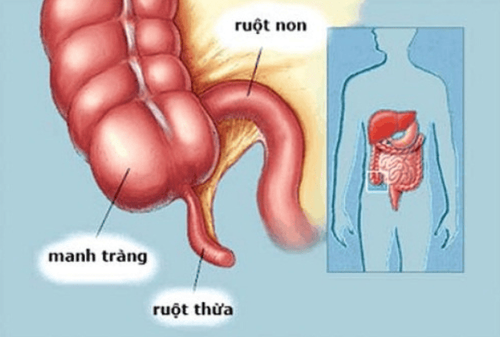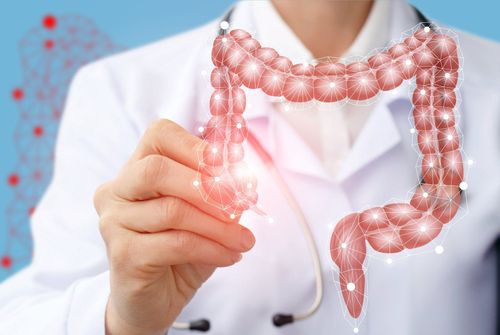This is an automatically translated article.
The article was professionally consulted by MSc Vu Van Quan - Department of General Surgery & Anesthesia, Vinmec Hai Phong International General Hospital.Tuberculosis is an infectious disease caused by the bacterium Mycobacterium tuberculosis. Tuberculosis of the ileum is a type of gastrointestinal tuberculosis, with symptoms that are easily confused with other diseases. Tuberculosis is common in people of working age, especially between the ages of 30 and 55. In addition, patients with intestinal tuberculosis often also have tuberculosis in other organs such as pulmonary tuberculosis, rarely urinary tract tuberculosis (most commonly renal tuberculosis).
1. What is ileocecal tuberculosis?
The last half of the small intestine is called the ileum. The stool will pass from the ileum to the cecum. The cecum is the first part of the colon that is about 6cm long and 7cm wide.
Tuberculosis of the intestine is a specific disease of the intestine caused by tuberculosis bacteria. It is a form of extrapulmonary tuberculosis. The disease often occurs secondary to tuberculosis in another organ. The disease can occur in both sexes with equal rates at all ages. Although it has decreased much compared to the past, but now gastrointestinal tuberculosis tends to increase again.
Tuberculosis of the intestine occurs due to 2 causes, primary and secondary:
Primary intestinal tuberculosis:
A rare type of tuberculosis, it occurs when TB bacteria enter the body through the gastrointestinal tract and are localized. in the intestine, then TB bacteria invade other organs. TB bacteria enter directly through eating and drinking, mainly by using fresh cow's milk and dairy products containing bovine TB bacilli, using food and drinking water contaminated with TB bacilli. Secondary intestinal tuberculosis:
Is intestinal tuberculosis common after patients have pulmonary tuberculosis, esophageal tuberculosis, oropharyngeal tuberculosis, peritoneal tuberculosis. It is currently estimated that approximately 20% of immunocompromised patients develop enteric TB infection with active pulmonary TB, and conversely about 25% of pulmonary TB patients also develop gastrointestinal TB.
Tuberculosis ileum g is the most common site in intestinal tuberculosis because this area is often stagnant, and at the same time it is the site of the most exchange of water and electrolytes, making this part very strongly absorbed and because This region also has the most lymphocytes.

2. Symptoms of ileocecal TB
Intestinal tuberculosis in general and ileocecal TB in particular are quite silent, signs of intestinal tuberculosis are often non-specific, so patients rarely come to the doctor in the early stages.
2.1 During the onset of the whole body: thinness, paleness, fatigue, fever in the afternoon, night sweats, ...
Gastrointestinal symptoms:
Nausea. Abdominal pain: dull abdominal pain, no fixed position, when abdominal pain often digs out, can relieve pain. Abdominal pain is often accompanied by abdominal bloating and defecation disorders: Loose stools 2-3 times a day, viscous, rotten stools. Prolonged loose stools, using antidiarrheal drugs have no effect. It is possible to alternate diarrhea with constipation, sometimes after a few days, it will recur. In the full-blown period:
The whole disease period manifests different symptoms depending on the disease:
Ulcerative form of the colon, colon:
The patient has a lot of abdominal pain, high fever, prolonged diarrhea. The abdomen is a bit big, there is a lot of gas, touching the abdomen does not see anything special. The stool is thin, stench, yellow, with pus, mucus and little blood. Rapid exhaustion, paleness, anorexia. Some patients are afraid to eat because when they eat, they have abdominal pain and diarrhea. Enlarged form - ileocecal:
The patient stops having loose diarrhea and has diarrhea with blood, mucus, and pus, never normal stools. Vomiting and abdominal pain. Examination of the right iliac fossa showed soft, tender tenderness with little mobility. Intestinal stenosis:
After eating, abdominal pain increases. At the same time, the abdomen appeared lumps and showed signs of snakes. After 10 to 15 minutes there is a slight movement in the bowel and a sensation of passing through the stricture, Koenig's sign. Abdominal examination showed no signs other than pain.

3. Treatment of ileocecal TB
The treatment of ileocecal tuberculosis is similar to that for peritoneal tuberculosis, pulmonary tuberculosis, ... is medical treatment. Medical treatment includes the use of drugs in combination with a reasonable diet (eating enough nutrients, especially protein, vitamins, should not eat a lot of powdered food)
Anti-TB drug treatment: divided into 2 stages of attack. The work and consolidation phase usually lasts at least 6 months. Previously, anti-TB therapies were extended to a maximum of 8 to 12 months, but recently, 6-month drug regimens have been shown to be as effective as standard 12-month treatment. Many doctors still extend the duration of treatment from 12–18 months. Current studies have shown that obstructive bowel lesions can be successfully treated with anti-TB drugs without surgery.
Surgical treatment is done to manage complications such as obstruction, perforation (pass or inlet or fistula) and massive bleeding that does not respond to classical treatment. Intestinal stricture is managed by surgical resection or resection of the bowel. Intestinal perforation was resolved by surgical resection and anastomosis rather than by simple suturing to avoid GI fistula. Bypass surgery such as ileostomy, ileostomy is not recommended for obstructive lesions because they can form blind rings leading to obstruction, leakage, malabsorption...
At Vietnam, is implementing a national TB prevention program. Patients with ileocecal TB in particular and TB in general should be treated in hospitals, specialized TB medical centers, which both help with TB management and patients also enjoy the following benefits: program support.
In order to prevent intestinal tuberculosis, it is necessary to keep hygiene in eating and living, not to use raw unprocessed cow's milk, when using immunosuppressive drugs such as corticosteroids, it is necessary to regularly monitor the immune status. of body. When there are symptoms of the disease, it is necessary to go to the doctor for timely diagnosis and treatment, to avoid the serious progression of the disease, endangering both themselves and the community.
Patients who have surgery at the Department of Surgery, Vinmec Hai Phong Hospital enjoy outstanding benefits including:
Short hospital stay, minimizing the cost of stay, reducing the risk of hospital infections. With cases of lithotripsy, inguinal hernia, customers can always go to work after 1 day of discharge from the hospital. Limit the use of antibiotics, reduce the risk of side effects, save costs, patients do not have to worry, fear when administering antibiotics and follow up after taking the drug. Recovery rate reached 90%, re-hospitalization 0%, postoperative infection 0%. The Early Post-Surgery Care Program provides comprehensive care to patients before, during and after surgery, helping to reduce hospital stay, improve treatment quality and reduce costs; reduce the rate of complications. ERAS has been shown to shorten the average length of stay from 8-10 days to 3-4 days. Insurance: Vinmec signed with many large private insurance partners. When customers are hospitalized, they are guaranteed and compensated at the hospital. Save a lot of customer's time and effort. Other advantages : Modern equipment; Service quality according to international standards; Highly qualified doctor; Patients do not need relatives to take care of them because they are cared for by a dedicated and attentive nursing doctor...
Please dial HOTLINE for more information or register for an appointment HERE. Download MyVinmec app to make appointments faster and to manage your bookings easily.














